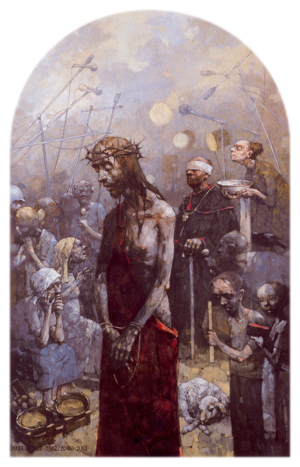|
Via Crucis by polish composer Paweł Łukaszewski, written in 2000 (for contratenor, tenor, baritone, reciter, mixed choir organ and symphony orchestra to the texts from the Bible in Latin) is a composition of duration of 60 minutes. It evolves by a manner of “mega-rondo”, i.e. a large rondo, wherein each of the thirteen stations is opened and closed by a very similar formula (in shape of refrain), built of a name of a station (choral male voices), an invocation :”Adoramus Te, Christe...” (choral female voices) and finally a lamentation “Qui passus est pro nobis...” (choral female voices), and instrumental interludios, based on themes of Polish Lenten songs, which symbolize passing between stations (scanned sounds in wood winds on a background of low bourdons of brass). One of the next element serving for consolidation of the formal construction of the whole are strokes (chord horizontals of all instruments, from one to fourteen strokes) which are to be recognized as numbering of stations (listener recognizes the idea starting with third/fourth stroke). The most distinguishing character can be noticed in Stations of the descent from the cross and of the burial (dynamics in refrains of inter-station passages and in the strokes numbering stations is softened).
There are many elements of archaizing of compositional language in Via Crucis. In the very sound layer it is achieved by numerous bourdons to stress austerity of harmony, frequently used low brass and high, a sort of medieval “pipes” (wood-winds in inter-station passages, in the ways between stations) and general roughness (tartness) of sound timbre; in a melodic layer – harmonically severe recitatives and melodeclamations; in choir texture – opposition: female voices–male voices, after the fashion of antiphonal chants (this concerns all “refrain” parts of choir as well as some “plot” parts, e.g. Third Station, Seventh Station). I also revert to practice of figures of speech (in terms of musical rhetorics) to maximally visualize my sound language. Due to this quite vivid pictures are achieved, like in the Third Station (sequence of invocations of singular voices of a cappella choir with last syllables lengthened in bourdon-like manner); Seventh Station (exclamations imagining groans and sighs of tormented Christ); Ninth Station (sounds going astray to illustrate Isaiah’s words: “Omnes nos quasi oves erravimus”); Tenth and Eleventh Station (culmination of the suffering of crucifiction has its equivalent in drammatic commotion in music and vibration of choral-orchestral texture); in the Stations of agony, descent from the cross and burial (dilution and congealment of musical occurences). Moreover in the last Station of the Way of the Cross I introduced a melody of a sad Polish Christmas carol in mood of lullaby “Jezus malusieńki”. This quotation symbolizes a birth for a new life while the death of a body. Such quotations are motivated by me in terms of expression, formal construction, idea and rhetorics.
While I consciously limited myself in “refrain” parts, in all fourteen Stations, and in the fifteenth which acts as coda, one can follow and perhaps experience an increasing dramaticism of the work. It reaches its summit in Golgotha-Stations (ten to fourteen) and in the final Fifteenth Station (Resurrection). Beside of general assumption of a kind of asceticism (less speaking – far more can be said than speaking much) listeners are envolved in the plot as it develops. I am interested in secrets of psychology of how large (long) works are perceived and I seek for my own assemblage of means of expression. The use of the “refrain” sections, apparently identical but still various each time, can somehow cancel, erase in receiver’s memory all that has happened. Thus after each Station listener stands as if in front of a new picture. This “reset”-function was acted by amorphic section of inter-station passage. In primordial “plot” sections (based eleven times upon the Bible and three times upon words of Isaiah, at the Stations of Christ’s falls – 3, 7, 9) we can find the music action very rich and varied: from ascetic fragments based only upon narrative parts (spoken or melodiously declaimed), through Stations of choral a cappella, up to very dramatic moments that use the rich choral and orchestral outfit (Stations no. ten, eleven and fifteen). In fifteenth Station I used organ (in C major), for it resounds on the day of the Resurrection during services in the Church.
|
EVENTS
2025 04 11 Katowice, PL
2025 04 11 Łódź, PL
2024 03 23 Wałbrzych, PL
2023 04 05 Białystok, PL
2023 04 02 Białystok, PL
2023 04 01 Białystok, PL
2023 03 26 Białystok, PL
2023 03 25 Białystok, PL
2023 03 19 Białystok, PL
2023 03 18 Białystok, PL
2023 03 12 Białystok, PL
2023 03 11 Białystok, PL
2023 03 05 Białystok, PL
2023 03 04 Białystok, PL
2023 03 03 Białystok, PL
2018 11 17 Cincinnati, USA
2018 07 08 Kraków, PL
2018 03 31 Wrocław, PL
2018 03 30 Wrocław, PL
2017 04 09 Dusseldorf, DE
2013 03 24 Szczecin, PL
2012 09 05 Wrocław, PL
2011 09 11 Wilno, Litwa
2009 04 05 Szczecin, PL
2008 03 29 Cambridge, UK
2008 03 28 Norwich, UK
2005 03 18 Olsztyn, PL
2002 04 26 Gdańsk, PL
2002 03 22 Kalisz, PL
2002 03 10 Częstochowa, PL
2002 03 08 Białystok, PL
|











